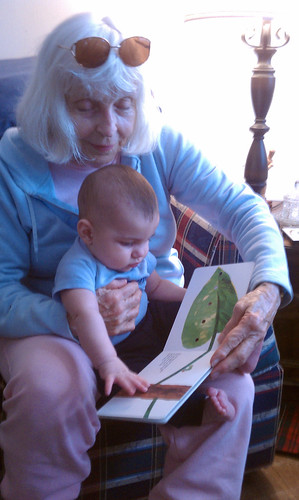StoryVisit was one of the "take-aways" I brought back.
StoryVisit is a web-based application developed to promote interaction between grandparents (or parents) and children who are remotely located. It is available on-line for free as part of a collaborative project between researchers from the Nokia Research Center, the Sesame Workshop, the University of Arkansas, and the MIT Media Lab
As soon as I saw the StoryVisit demonstration, I knew that the concept had potential to be useful to promote literacy and social communication among students with special needs, such as those who have autism spectrum disorders. (My story of how I tweaked StoryVisit for use with students is located near the end of this post.)

Credit: Nokia Research
One of the good features of the StoryVisit website is that it supports dialogic reading between the adult and child, by providing a Sesame Street character embedded in the story to help guide the process.
According to Grover J. Whitehurst, this method can support language development in young children. In dialogic reading, the adult who reads with a child helps the child take a more active role in the process by following what is known as "PEER": Prompting the child to talk about the story, evaluating the child's response, expanding the response by rephrasing and elaborating on what the child has said, and repeating the prompt to assess what the child has learned or grasped from the story. This can include a discussion about the pictures that accompany the story, and questions that guide the child to think about the relationships between the characters, or prompts that help the child make predictions and draw inferences.
To get an understanding of the StoryVisit application, first take a look at how it works with adults and children - below are two related videos and an abstract from the StoryVisit presentation at CHI 2011 and a couple of related videos:
Here is short preview:
"StoryVisit allows children and long-distance adults to experience a sense of togetherness by reading children's story books together over a distance. StoryVisit combines video conferencing and connected books: remote grown-up and child readers can see and hear each other, and can also see and control the same e-book. We report on research with 61 families - over 200 users including parents, children and long-distance readers - who used StoryVisit in their homes with a long-distance reader for at least one reading session. In addition, we report qualitative findings regarding nineteen of the families who participated in telephone interviews and four families who were monitored and interviewed by researchers at home. Results show that connected e-book video chat sessions last about five times as long as the typical video chats reported in previous research on families with young children. Moreover, the addition of an animated character increased session lengths by another 50%. StoryVisit usage peaked for families with three year olds, showing that sustained distance interactions with very young children are possible if communication technologies incorporate joint activities that engage children and adults."
On my first morning back at Wolfe, I decided to use StoryVisit with two high school-level students who have autism and cognitive delays. My goal was to familiarize the students with Storyvisit so they could use it to read stories to younger elementary-level students with autism who are in a self-contained classroom. I went to the Storyvisit website and registered Wolfe school as the "Wolfe family", using some of the teacher's email addresses as "family members".
RELATED
Try StoryVisit by signing up at Storyvisit.org
NRC (Nokia Research Center) launches Story Visit pilot in association with Sesame Workshop
Intervention: Dialogic Reading (2/8/07), US Department of Education, Institute of Education Sciences (What Works Clearinghouse)
Dialogic Reading Video Series, NCLD Editorial Staff, 11/1/09
Dialogic Reading: An Effective Way to Read to Preschoolers (Grover J. Whitehurst -1992, Reading Rockets Archive)
Hayes Raffle's website
Family Story Play (First version of StoryVisit)
Family Story Play pdf (CHI 2010 presentation)
SOMEWHAT RELATED
Since the Storyvisit activity was so positive with my students, I decided to dig a little deeper. I use video quite a bit with students with autism spectrum disorders, and work with students to establish joint-attention skills and behaviors. My hunch is that this is an area that warrants further exploration, especially for children and teens with autism spectrum disorders, their classmates, peers, and families.
The Co-Viewing Connection: "A blog for grown-ups about using media and technology with kids"
The New Coviewing: "Promoting Children's Learning Through Joint Media Engagement"
Interesting:
Game On.... Girls: Associations Between Co-playing Video Games and Adolescent Behavioral and Family Outcomes (Sarah M. Coyne, Laura M. Padilla-Walker, Laura Stocdale, Randal D. Day, Brigham Young, School of Family Life, in Journal of Adolescent Health, 2/3/11)
Why this is important:
My grandson, "reading" at 6 months old:

My mom and my grandson reading together:

*"The ACM Conference on Human Factors in Computing Systems is the premier international conference of human-computer interaction. CHI 2011 focuses on leveraging our diversity and connecting people, cultures, technologies, experiences, and ideas."
Cross-posted on the Interactive Multimedia Technology blog.



No comments:
Post a Comment